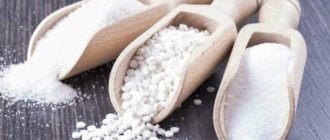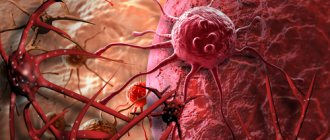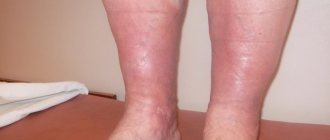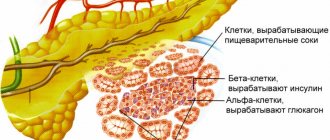How to get rid of type 1 diabetes?
Many of those who are faced with this disease are trying to find a magical method that will bring healing to them or their loved ones. But does it really exist? And perhaps there are those who have cured this disease?
At present, it is impossible to completely cure type 1 diabetes.
In the field of alternative medicine, you can find dubious information that there are still chances to get rid of diabetes forever and that someone has supposedly been cured, but attempts to turn to its methods will lead nowhere: cases of recovery from this form of diabetes have not been recorded.
This is due to the fact that over 80% of beta cells die, and no way to restore them has been found.
Research that may help people with diabetes in the future is underway, and in a few years it will be clear when this disease will be cured.
The best option is to follow your doctor's recommendations, take insulin regularly, monitor your glucose levels, and eat healthy.
How to cure diabetes using various techniques
The principles that will answer the question of how to effectively treat diabetes mellitus in adults are described below. These include medications, traditional methods of treatment, diet and sports.
Taking medications
The medication is prescribed when diabetes is in its late stages or serious complications have begun to develop. Recently, one of the most effective drugs for the treatment of diabetes mellitus of this type are Forxiga and the drug Velmetia.
Medicines for type 2 diabetes have the following effects:
- enhance insulin absorption;
- reduce glucose consumption by the intestines;
- deliver sulfonylurea derivatives;
- regulate insulin levels.
Additional medications that may be prescribed include:
- aimed at reducing sugar;
- stimulating the production of insulin by the pancreas.
Insulin pump
To understand how to quickly cure diabetes, you should definitely consult a doctor. Type 1 diabetics will require insulin. To administer it, you can use pumps, which are becoming increasingly popular all over the world.
The advantages are:
- Correction of the dose and regimen of insulin administration.
- It is possible to select a minimum step of 0.1 units.
- Painless.
- Normalization of glycated hemoglobin.
- Maintaining target glucose levels without spikes.
Who needs a pump?
The pump is used for type 1 diabetes. It can also be installed in children, pregnant and nursing mothers, with frequent episodes of hypoglycemia, with severe type 2 disease, during a constant increase in glucose in the morning.
Today, the search for improved methods that will help solve the problem of how to cure diabetes continues. It is worth saying that over the last decade many technologies have already been developed that in the future will provide significant relief to the patient and make therapy more effective.
Stem cells
In the future, therapy using stem cells is the most promising technique. The bottom line is that B cells are grown in laboratories, which have the ability to transform into any unit of the body. Scientists were able to reproduce the development process of these cells in mice and cure the animals from lack of insulin.
Vaccine
There are vaccinations for diabetes that aim to “teach” the immune system not to kill B cells. The DNA molecule is modified and helps stop inflammatory processes, and also stops the development of the disease.
Pancreas transplant
Another way to get rid of diabetes, which requires donor material. The pancreas is inserted through a central incision in the abdomen and placed on the right side of the bladder, the vessels are sutured.
How to learn to live with illness
If the disease cannot be cured, you need to be able to live with it, there are basic rules:
- Take control of your body: monitor your sugar levels, monitor your blood pressure, visit a doctor. In other words, become the master of your body, observe it.
- Whenever you leave home, it is recommended to take a piece of sugar or juice with you. This will help avoid sudden changes in blood glucose. And sugar is absorbed faster than anything else.
- Be aware that neglecting the disease can lead to aggravation of the problem. The more the patient knows about his illness, the better for him.
Fraudulent methods
Today the Internet offers a lot of ways to get rid of diabetes by using “miracle drugs” and “methods”, but in this case the goal is the same - profit. Not only will such treatment not bring any benefit, but there is also a huge likelihood of harm.
Charlatans may offer:
- Removal of toxins.
- Herbal medicine.
- Devices with vibration.
- Working with the subconscious.
- Bioenergy.
All these methods will not help! Only contacting a specialist will help solve the question of how to cure and forget about diabetes mellitus.
About the treatment of diabetes in children
The child's body can also be affected by the disease. If this happens, the doctor will recommend keeping a diary of injections, monitoring the baby’s condition daily, sticking to a complex carbohydrate diet, and using physical activity. Only intensive therapy over several years will help overcome the disease.
Author: Oksana Sviridova
Source: med88.ru
What is the diabetes honeymoon?
Insulin therapy is the only method that allows a person with this type of diabetes to live a full life. Insulin medications need to be administered from the moment of diagnosis until the end of life.
When the use of drugs begins, all the symptoms that were present in the patient weaken, and a specific state is observed for some time: diabetic remission (also called the honeymoon).
This period is divided into stages:
- Stage 1. Insulin therapy begins, and the small part of beta cells that managed to survive are given the opportunity to recover. Before the use of insulin, these cells were not able to perform their functions.
- Stage 2. After some time (several weeks or one to two months), the beta cells return to producing the hormone, which, in combination with the use of insulin therapy, leads to hypoglycemia, and there is a need to reduce the dosage or abandon additional insulin completely, which rarely occurs.
- Stage 3. The autoimmune process takes over the remaining beta cells, and there is a need to restore the dosage.
Some patients during this period decide that they have been cured, but this is not the case, and over time the honeymoon will end. Its duration depends on the number of surviving beta cells and the activity of autoimmune antibodies and averages a month.
Stopping insulin therapy during this period without the instructions of the attending physician is extremely dangerous: this leads to a decrease in the duration of remission and increases the risk of developing a labile type of diabetes, which is difficult to control.
A person with this form of diabetes cannot live without insulin.
Daily injections
Once diagnosed, the patient should be prepared for daily injections. After the start of such treatment, the body reacts very interestingly to the intake of the synthetic hormone - the sugar level returns to normal and the patient’s well-being improves significantly. This condition lasts for the first few weeks and is due to the fact that after the first injection, the process of destroying beta cells is suspended for some time. A common mistake many patients make is that they refuse insulin during this period. Such a rash step can lead to the development of coma or even death of the patient.
If during this period you do not refuse injections, but simply lower the administered dose of insulin, you can prolong this condition for a long time.
There are four types of insulin based on the duration of its action - from ultra-short, which begins to act immediately, to long-acting hormone, which gradually lowers sugar levels throughout the day.
It should be understood that insulin administered by injection is an analogue of this hormone. The analogue is produced using special bacteria bred in a special way for the synthesis of insulin.
The frequency and dosage of injections vary depending on the patient's condition and lifestyle. If the diet is strictly followed, the dosage is reduced, but insulin cannot be completely abandoned.
The number of injections and dosage are prescribed by the doctor on an individual basis. When asking how type 1 diabetes can be treated in young children, you should also consult your doctor. Treatment of children and adults is not fundamentally different, but requires adjustment of the frequency of insulin administration and dosage of the drug.
Who provides the treatment?
To get a consultation with an endocrinologist, you need to contact a therapist who will write a referral and prescribe basic tests.
Diabetes is treated under the supervision of an endocrinologist, who provides consultations and prescribes diagnostics.
An endocrinologist who specializes in diabetes is called a diabetologist.
He monitors the treatment of type 1 diabetes, gives advice and selects menus.
What tests are needed?
Diagnosis of diabetes does not cause difficulties. To make a diagnosis, glucose and glycohemoglobin levels are measured.
If the sugar concentration on an empty stomach exceeds 7.0, and after a meal - 11, this clearly indicates the presence of the disease.
Once the diagnosis is made, treatment for type 1 diabetes begins.
Once the diagnosis is determined, the patient should undergo periodic preventive examinations.
Treatment of diabetes with folk remedies
For type 1 diabetes, treatment with folk remedies is auxiliary. Various recipes are used from herbs that have a hypoglycemic effect. Some plants have a rich chemical composition that accelerates overall metabolism.
A decoction of flax seeds has a positive effect on the body. To prepare the recipe, you need to pour 15 g of seeds into a glass of water and boil for 5 minutes. Set aside the resulting liquid and drain it. Take the medicine one tablespoon three times a day 30 minutes before meals. The course of treatment is 1 month.
Read also Basic recommendations for diabetics
The healing properties of linden blossom have been known since ancient times. Linden blossom not only reduces glucose levels, but also saturates the body with essential vitamins. To prepare linden infusion you will need 2 cups of dry linden blossom and 3 liters of water. The linden is filled with water and boiled for 10 minutes. Then the broth is cooled and filtered. The liquid should be stored in the refrigerator. The decoction is used instead of water and tea. After finishing taking the resulting liquid, you need to take a break for 1 month and repeat the course of treatment.
Collections of medicinal plants allow sugars to be stabilized. Motherwort leaves, mulberry leaves and strawberry leaves in the right ratio have a good therapeutic effect. To prepare the decoction you will need 1 teaspoon of crushed motherwort, 1 dessert spoon of dried mulberry leaves, 1 tablespoon of strawberry leaves. The resulting mixture should be poured with a glass of boiling water and boiled for 5 minutes. Cool the broth and strain. For therapeutic purposes, it is necessary to consume the resulting liquid 2 tablespoons 30 minutes before meals three times a day.
Modern methods of treatment
The control and treatment of type 1 diabetes mellitus is based on the following methods:
- Insulin therapy. There are different types of insulin medications that differ in their duration of action. Short insulin is used shortly before meals, and long insulin is used to maintain hormone concentrations throughout the day.
- Diet. Following a diet helps control glucose levels and improves well-being.
- Physical activity. Regular exercise helps lower glucose concentrations.
- Self-control. The patient should be able to calculate the dosage depending on the level of physical activity and nutrition, and his relatives should know the basics of first aid.
Graph of the activity of each type of insulin during insulin therapy
Principles of treatment of type 1 diabetes mellitus
When treating type 1 diabetes, you should adhere to certain principles that reduce risks and ensure good health:
- Insulin therapy. Injections should not be skipped to prevent the occurrence of hyperglycemia.
- Glucose control. During the day, it is necessary to measure the glucose concentration using a glucometer in order to use medications in a timely manner if disorders occur.
- Keeping a diary in which you should record your sugar levels and other important information about the disease. It can be either electronic or paper.
- Power control. It is necessary to take into account the content of glucose and carbohydrates daily.
- Preventive medical examinations. In order to timely identify disorders that are caused by the influence of T1DM, you need to periodically undergo examinations and consult with doctors.
- Healthy lifestyle. Alcoholic drinks and smoking adversely affect the general condition of the body, make it difficult to control glucose levels and increase the risk of complications.
- Monitoring blood pressure levels. Arterial hypertension adversely affects the course of the disease, therefore, when blood pressure increases, it is necessary to take antihypertensive drugs.
- Physical activity. Exercises should be performed regularly and loads should be measured to prevent overwork. During physical activity, it is important to check your sugar concentration to prevent hypoglycemia.
- Studying information about the disease. It is useful to know as much information as possible about the pathology in order to provide quality care to yourself. Information about new scientific developments that will make life with diabetes easier will also be valuable.
The sooner a person begins treatment and the more carefully he adheres to the recommendations, the lower the risk of complications.
What medications are prescribed for diabetes?
Despite the fact that cure is completely impossible, regular use of insulin drugs allows you to live without serious restrictions. Also, drug treatment for type 1 diabetes mellitus may involve the use of additional drugs.
There are several types of insulin drugs, depending on the duration of the effect and the rate of absorption:
- Ultra short action. It is administered (usually the stomach is the injection site) before or immediately after a meal. The effect appears within a minute and lasts no more than five hours. Some ultra-short-acting drugs are taken 10-15 minutes before meals.
- A short. The medicine is administered 20-40 minutes before meals and lasts no more than 8 hours. Reaches maximum concentration after 2 hours.
- Average. This variety is designed to maintain normal hormone concentrations throughout the day. The duration of action is 12 hours. Inserted into the thigh area.
- Long. The duration of action lasts for 24 hours. But this remedy does not allow maintaining normal concentrations of the hormone during this period and is used to maintain its level at night.
There are various means for regular administration of drugs:
- Individual syringe. Classic instrument for administering insulin. Affordable, but not always convenient and requires skills to use. Suitable in cases where it is not possible to use another method of administration.
- Syringe pen
- Syringe pen. A convenient, inexpensive and compact instrument with which you can quickly and almost painlessly administer the exact dose of medication.
- Dispenser pump. It is a small electronic device that controls the process of regular hormone administration. The catheter, which needs to be changed regularly, is inserted under the skin and secured with a tape. Connected to it is a device that administers medicine depending on the mode selected by the user.
The following medications are also useful for treating diabetes:
- Therapeutic patches that maintain the desired glucose concentration.
- Medicines that improve the condition of the pancreas, lower blood pressure and reduce body weight.
- Glucose tablets that you need to carry with you at all times to drink during hypoglycemia.
- Medicines that are used to treat diseases caused by diabetes. Prescribed by a doctor based on diagnostic results.
Type 1 diabetes without insulin: can it be cured forever and at home?
What it is?
The pancreas produces the hormone insulin. It is necessary to normalize the metabolic process. Thanks to insulin, sugar is converted into glucose, and it spreads throughout the cells. Insulin directly affects the level of sugar in the body. If, as a result of some negative effects, little of this substance is produced, it is not produced at all, or the body’s cells lose sensitivity to it, a disease called diabetes mellitus begins. With this disorder, the body's cells experience hunger and do not receive the necessary nutrition. Water does not stay in them, tissue functions are disrupted. Changes in glucose levels lead to deterioration in health. The skin suffers and teeth are destroyed. Failures occur in the central nervous system and kidneys. Vision deteriorates, obesity, atherosclerosis, and hypertension often develop. The whole body suffers.
What to do if you have diabetes?!
Read more >> |
Diabetes mellitus, left to its own devices, can cause loss of vision, gangrene of the legs, heart attack, stroke, and kidney failure. If there is a sudden change in the amount of sugar in the blood, a hypo- or hyperglycemic coma occurs, which can be fatal.
Diabetes mellitus is one of the most common diseases on the planet. More than 10% of the population suffers from this disease, and doctors identify new cases every year. According to the international classification ICD-10, its coding is E10-E14.
ul
Causes of the disease
Type 1 and type 2 diabetes mellitus have different mechanisms of occurrence. Thus, the insulin-dependent form appears as a result of congenital disorders or when pancreatic cells are damaged by infections (for example, hepatitis, rubella). Cell death can be caused by exposure to toxic substances (certain drugs, pesticides, nitrosamines). When more than 80% of cells are dysfunctional, type 1 diabetes occurs. It is often accompanied by other autoimmune diseases, in particular thyroid pathologies. Diseases that destroy pancreatic tissue also affect insulin synthesis.
As for type 2 diabetes, with it the pancreas is fine. The following violations can provoke its appearance:
- Genetic predisposition.
- Obesity. Excess fat helps reduce tissue sensitivity to insulin.
- Poor nutrition. The predominance of carbohydrate foods in the diet, especially light carbohydrates, plus a small amount of fiber increases the chances of developing diabetes.
- Pathologies of the heart, blood vessels, ischemia, atherosclerosis, hypertension also reduce the sensitivity of tissues to the hormone.
- Constant stress. This condition causes an increase in adrenaline, norepinephrine, and glucocorticoids in the body, which leads to the formation of this pathology.
- Taking certain medications. For example, artificial hormones, diuretics, cytostatics and drugs that lower blood pressure.
In addition, certain chronic diseases contribute to the occurrence of type 2 diabetes. For example, adrenal insufficiency.
ul
Clinical picture
Type 1 diabetes usually makes itself felt suddenly and unexpectedly. The second type of disease, on the contrary, gradually increases its manifestations. These two forms, as already mentioned, have different causes, which means their symptoms are also different. But there are a number of common signs:
- dry mouth, constant thirst, forcing you to drink a lot of liquid;
- frequent, copious urination;
- excessive appetite;
- drying of the skin and mucous membranes;
- itching of the skin, especially in the genital area;
- pustular rashes on the body;
- weakness, apathy, fatigue;
- insomnia;
- cramps of the calf muscles;
- changes in vision for the worse.
Specific symptoms of insulin-dependent diabetes are heaviness in the legs, weight loss with normal or excess nutrition, and slow healing of skin lesions. Ketoacidosis changes the composition of urine, giving it the characteristic smell of acetone. The same smell can come from your mouth. This condition causes nausea and vomiting. The patient's companions include irritability and a constant feeling of hunger.
The main symptom of the insulin-independent form is obesity, which is both a cause and a consequence of diabetes. As well as a periodic decrease in blood sugar levels (hypoglycemia), causing increased sweating, trembling in the hands and body, and increased heart rate. Indirect signs of NIDDM can be a large amount of cholesterol and arterial hypertension. Dark, rough spots form on areas of the skin exposed to friction. Possible ulceration.
ul
Diagnostic methods
Diagnosing diabetes mellitus begins with taking a medical history. Many characteristic signs and symptoms make it possible to suspect its presence in a patient who comes to the clinic.
What to do if you have diabetes?!
We recommend reading an exclusive article on how to forget about diabetes forever... Read more >> |
The following tests confirm or refute these suspicions:
- determination of the amount of glucose in the blood (on an empty stomach, blood is taken from a finger);
- measuring fluctuations in blood sugar levels throughout the day;
- determining the amount of insulin;
- glucose tolerance test;
- blood test for biochemistry;
- blood test for the concentration of glycosylated hemoglobin;
- urine test to study the number of white blood cells, glucose and protein;
- ultrasound examination of internal organs;
- Rehberg's test.
Additionally, blood tests for electrolytes, urine tests for the presence of acetone in it, examination of the fundus, and an electrocardiogram may be prescribed.
Patients with diabetes need to regularly independently monitor the amount of sugar in the body. Of course, it is impossible to carry out research in laboratories every day. Therefore, to simplify the patient’s life, convenient testing devices (glucometers) have been created that can be used at home. If self-identified indicators worsen, you should contact your doctor again.
ul
Treatment and diet
There is no way to get rid of diabetes, no matter what type it is. Therefore, treatment is aimed at lowering blood sugar levels, improving metabolism, eliminating symptoms, and preventing the development of complications. To implement correct therapy, constant monitoring of blood glucose levels is necessary.
Treatment for types 1 and 2 is different. In the first case, insulin is not produced in the required quantities, so the patient needs daily injections. The patient himself or someone close to him (if we are talking about a child or an incapacitated person) learns how to give an injection correctly. There are long-acting insulin preparations, the effect of which lasts throughout the day, and short-term ones.
For non-insulin-dependent diabetes, medications that lower sugar levels are prescribed:
- sulfonylureas;
- biguanides;
- meglitinides;
- alpha-glucosidase inhibitors;
- Thiazolidinediones.
The type of drug is determined by the doctor based on the characteristics of the disease and the patient’s body.
Treatment of both types of diabetes is impossible without diet. Fractional meals 4–5 times a day are recommended, with an even distribution of carbohydrate foods. Prohibited:
- fried, spicy, salty foods;
- smoked meats;
- coffee;
- cocoa;
- alcohol;
- too sweet fruits (bananas, grapes).
As for confectionery products, you cannot eat their regular versions. Currently, there are special sweets and sweeteners for diabetics, which can be consumed after consulting a doctor.
The menu of a diabetic patient should consist of cereals, lean meat, poultry, fish, dairy products, and vegetables. You can eat fruits that are not too sweet - apples, citrus fruits, pomegranates, kiwi, various berries, as well as nuts and black bread. It should be remembered that a patient with diabetes should not eat unfamiliar foods without making sure that they are safe for themselves.
A sedentary lifestyle is diabetes’s “best friend.” Therefore, feasible physical activity is recommended for diabetics. With physical activity, blood circulates better throughout the body, providing high-quality nutrition to cells and tissues. And with NIDDM, physical exercise will help get rid of extra pounds, which only increase the severity of the disease.
ul
Complications and prognosis
In the absence of necessary treatment, complications of diabetes mellitus may occur:
- stroke, heart attack, hypertension;
- trophic ulcers;
- loss of vision;
- renal failure;
- gangrene;
- paralysis of limbs.
However, with proper maintenance therapy, the risk of complications is minimized, no matter what causes diabetes.
It is important to understand that diabetes is forever. It is impossible to get rid of the disease, which means you need to learn to live with it. Of course, this pathology imposes a number of restrictions on a person in terms of nutrition and obligations (constantly monitor the amount of sugar in the blood). But if you vigilantly monitor your well-being, regularly visit your doctor and do not indulge your own weaknesses, you can live a full, happy life for many years.
As for the prevention of diabetes, it consists of an active, energetic lifestyle, a balanced diet without harmful excesses, and giving up bad habits, especially the abuse of alcohol and sweets. It is important to carefully monitor your weight to avoid obesity. Of course, insulin-dependent diabetes is an unpredictable disease, and such prevention will not provide a guarantee against it. However, a healthy lifestyle can at least partially protect against type 2 diabetes.
ul
How to eat if you have diabetes?
When suffering from diabetes mellitus, diet and treatment tactics depend on the age and health of the patient. When developing a diet, chronic diseases are taken into account.
Basic principles of nutrition:
- It is impossible to treat and control diabetes without following nutritional rules. The diet should be varied,
- It is better to choose food that contains a minimum amount of dyes and preservatives,
- Create a specific diet and stick to it,
- You need to eat at least five times a day,
- Do not use granulated sugar
- Don't drink alcohol.
If there is a need to drink an alcoholic drink, before use you need to reduce the dosage of insulin medications and combine this with food, otherwise there is a risk of hypoglycemia.
The basis of nutrition should be the following products:
- Vegetables,
- Cereals,
- Greenery,
- Legumes,
- Fruits and berries low in sugar (in moderation),
- Milk and milk-based products with low fat content,
- Fish and meat with low fat content,
- Eggs,
- Seafood.
It is acceptable to consume dried fruits softened in water, juices, fruits with a high sugar content and berries, except grapes, in limited quantities.
The following products are not allowed for consumption:
- Confectionery,
- Fish and meat products with high fat content,
- High fat dairy products
- Sweet soda,
- Juices and juice-containing drinks produced in production,
- Smoked products,
- Canned food,
- Products made from premium flour,
- Sauces with high fat content,
- Pepper, mustard and other spicy additives.
Also, you can eat no more than 10-20 bread units (XE) per day. Using XE, the concentration of carbohydrates in food is determined. 1 XE - approximately 15 g of carbohydrates. Some doctors recommend reducing XE to 2-2.5 and increasing protein intake.
Type 1 Diabetes Meal Plan
Diagnostics
To diagnose type 1 diabetes, you need to measure your sugar in one of the following ways:
- fasting blood sugar test;
- two-hour glucose tolerance test;
- analysis for glycated hemoglobin.
Results that indicate a person has diabetes:
- Fasting plasma glucose 7.0 mmol/L or higher.
- When conducting a two-hour glucose tolerance test, the result was 11.1 mmol/L or higher.
- A random blood sugar reading is 11.1 mmol/L or higher and there are symptoms of diabetes.
- Glycated hemoglobin HbA1C - 6.5% or higher.
It is enough to fulfill one of the conditions listed above so that you can confidently make a diagnosis of diabetes mellitus. A fasting blood sugar test is less sensitive than others.
The two-hour glucose tolerance test is inconvenient because it takes a long time and blood must be drawn several times. Analysis for glycated hemoglobin is convenient and reliable.
It is done for diagnosis, as well as to monitor the effectiveness of treatment. If you have a home glucometer, just measure your sugar with it, without having to go to the laboratory.
If the result is above 11.0 mmol/l, this is definitely diabetes.
Due to insulin deficiency, cells cannot absorb glucose and switch to feeding on fats. In this case, many by-products are formed - ketone bodies.
/ They cause the smell of acentone from the mouth and acidosis - a violation of the acid-base balance in the body. Diabetic ketoacidosis is a serious complication that is life-threatening and requires emergency medical attention.
Its symptoms have been listed above. It is advisable to diagnose diabetes early and begin treatment to prevent the development of ketoacidosis.
What physical exercises will help with treatment?
You can also fight diabetes with the help of physical exercises, which can reduce sugar concentrations, but require caution. Before starting a workout, you need to check your glucose levels. If its level is below 5.5 mmol/l, you need to raise it: eat carbohydrate foods.
Optimal sugar levels for training are from 5.5 to 13.5 mmol/l. If glucose rises above 14 mmol/l, physical activity is unacceptable due to the risk of ketoacidosis.
If sugar drops below 3.8 mmol/l, physical activity should be interrupted.
Recommendations for training:
- In the middle of your workout, you should pause and measure your sugar again.
- It is better to train in nature to achieve high performance,
- If the workout lasts 30-40 minutes, it is recommended to do it no more than five times a week, and if its duration is 1 hour, it is enough to train three times a week,
- The loads should be within your strength and should be increased gradually,
- To be able to raise your sugar levels, it is important to take carbohydrate foods with you,
- Before starting training, you should consult your doctor.
If there are any signs of deterioration in health, you should stop exercising.
When is insulin prescribed?
It is not always the case that a diabetic needs additional injections, but there are situations when insulin is prescribed for periodic or continuous administration. Indications for this are the following conditions:
- Insulin-dependent diabetes (type 1).
- Ketoacidosis.
- Coma – diabetic, hyperlaccidemic, hyperglycemic.
- Carrying a child and childbirth against the background of diabetes mellitus.
Today there is a practice of managing pregnancy for women with diabetes, but in this case strict control is required
If diabetic coma occurs in type 1 diabetes, it is accompanied by ketocidosis and critical dehydration. The second type of disease in this case causes only dehydration, but it can be total.
The list of indications continues:
- If non-insulin-dependent diabetes is not treated in other ways, that is, therapy does not give positive dynamics.
- Greater weight loss is observed in diabetes mellitus.
- The development of diabetic nephropathy, accompanied by a failure of the nitrogen excretory function of the renal nephrons in type 2 diabetes.
- The presence of significant decompensation of type 2 diabetes mellitus, which can occur against the background of various factors - stress, infectious diseases, injuries, surgical procedures, exacerbation of chronic ailments.
According to statistics, 30% of all patients are prescribed insulin for type 2 diabetes.
What are the features of treatment in children?
Treatment for type 1 diabetes is exactly the same as for adults, but the dosage of insulin drugs varies depending on age:
- 0.5-1 IU in children under 6 years of age,
- 2-4 units in school-age children,
- 4-6 units in adolescents.
Syringe pens that are easy to use work well for administering insulin to children. It is also important to tell your child about the characteristics of his illness and self-help methods. It is important to start treatment for type 1 diabetes on time to reduce the likelihood of complications.
Symptoms and causes
One of the properties of type 1 diabetes is the rapid development of pathology.
Type 1 diabetes usually causes acute symptoms:
- strong thirst;
- dry mouth;
- frequent urge to urinate, including at night;
- the child may sweat while sleeping;
- insatiable hunger and at the same time inexplicable weight loss;
- irritability, hysterics, mood swings;
- fatigue, weakness;
- blurry vision;
- in women - fungal vaginal infections (thrush), which are difficult to treat.
Unfortunately, in most cases, people with type 1 diabetes and their loved ones ignore these symptoms until ketoacidosis develops. This is an acute complication that requires emergency medical attention.
Symptoms of diabetic ketoacidosis:
- dry skin, obvious dehydration;
- frequent deep breathing;
- smell of acetone from the mouth;
- lethargy or loss of consciousness;
- nausea and vomiting.
Physical training
Physical activity for diabetes mellitus of the first and second types is simply necessary. They accelerate metabolic processes and improve the breakdown of glucose, which allows you to keep blood sugar within normal limits without the use of insulin drugs.
Sport helps control the course of diabetes and prevent the development of serious complications associated with it.
Loads must be moderate. You need to exercise no more than 40 minutes a day. It is advisable to conduct training every other day. If you exercise more often and for a long time, this can lead to a “side effect” - a significant decrease in blood sugar and the onset of a hypoglycemic crisis.
Important! Before going to training, it is necessary to check your blood sugar levels. If it is below 5 mmol/l or above 13 mmol/l, then you should stop exercising, since at such sugar levels they can be dangerous.
Encapsulation of pancreatic beta cells
A good result for the treatment of diabetes is caused by a new biological material that can deceive one’s own immune system. The material became popular thanks to scientists from the University of Massachusetts and Harvard. The technique was successfully tested on laboratory animals and had no side effects.
Expert opinion
Guseva Yulia Alexandrova
Specialized endocrinologist
Read also: What role do vitamins play in diabetes?
To conduct the experiment, pancreatic islet cells were grown in advance. The substrate for them was stem cells, which, under the influence of the enzyme, were transformed into beta cells.
After obtaining a sufficient amount of material, the islet cells were encapsulated with a special gel. The gel-coated cells had good permeability to nutrients. The resulting substance was administered to experimental laboratory animals suffering from diabetes mellitus via intraperitoneal injection. The finished islets were inserted into the pancreas.
Over time, the pancreatic islets produce their own insulin, limiting themselves from the influence of the immune system. However, the lifespan of the implanted cells is six months. Then a new replanting of protected islands is required.
Regular administration of islet cells enveloped in a polymer shell allows you to forget about insulin therapy forever. Scientists plan to develop new capsules for islet cells with a prolonged lifespan. The success of clinical trials will provide impetus for maintaining long-term normoglycemia.
Reasons for the development of the disease
Type 1 diabetes usually occurs in young people. These are patients who are not yet 30–35 years old, as well as children.
The development of pathology occurs as a result of disruptions in the normal functioning of the pancreas.
Since it is this organ that is responsible for producing the hormone insulin in the amount required for a person. As a result of the development of the disease, beta cells are destroyed and insulin is blocked.
Sanatorium treatment and rehabilitation
Physiotherapeutic methods are prescribed for all forms of diabetes mellitus, provided that it is compensated. Their use improves the functioning of the pancreas, autonomic regulation of vascular tone, and increases the overall resistance of the body.
The maximum effect can be obtained by combining natural and physical factors. This happens during the period of spa treatment. Patients receive dietary nutrition, under the supervision of a physical therapy instructor, master exercises and learn to control their intensity, and learn self-massage techniques.
To improve the formation and release of insulin, effects are applied to the pancreas area:
- electrophoresis of heparin, nicotinic acid, magnesium, copper, zinc;
- pulse currents (sinusoidally modulated);
- high-frequency UHF therapy;
- ultrasound;
- magnetotherapy.
Physiotherapy for diabetes
Common physiotherapy techniques for type 1 diabetes include:
- electrosleep – calms, reduces blood pressure, improves the absorption of oxygen and glucose by brain tissue;
- transcranial electroanalgesia with pulsed currents – normalizes the activity of the autonomic system, relieves fatigue and headaches;
- intravenous blood irradiation – increases the function of the immune system, stimulates metabolic processes, prevents the progression of atherosclerosis;
- general magnetic therapy – restores microcirculation and tissue metabolism;
- hyperbaric oxygenation sessions – increase the oxygen capacity of the blood, reduce sugar levels, increase insulin sensitivity;
- taking mineral waters improves the functioning of the liver and pancreas, stimulates the activity of the intestines, which cleanses the body of excess glucose and cholesterol;
- baths with oxygen, radon, turpentine, hydrogen sulfide, iodine-bromine - normalize metabolism, the functioning of the cardiovascular and nervous systems.
Electroson
Review of means for administering insulin
There are several options for insulin injections, each of which has a number of nuances.
Table No. 1. Types of insulin injections
| Device name | Advantages | Flaws | Peculiarities |
| Insulin disposable syringe | The simplest and most inexpensive device. | The drug is taken before the injection, so a patient suffering from diabetes should always have a bottle of insulin and several sterile syringes with him. The syringe scale is not ideal; there is an error of about 0.5 units - in some cases this can lead to complications. If two different insulins are prescribed, sometimes difficulties arise in mixing them, especially if we are talking about a child or an elderly patient. The syringe needle is thicker than other devices, which means the injection of the drug will be more painful. | There are syringes in which the needle is removed; when used, part of the insulin remains in the syringe. But if you use a syringe with an integrated (built-in) needle, then the drug is injected completely. |
| Syringe pen | This is a more modern, reusable device that can last 2-3 years. The syringe pen is compact, easy to use, painless administration. Insulin therapy using a syringe pen is recommended for infants, the elderly and patients with poor vision. The scale is more accurate. | This is a more expensive device, in addition, a diabetic needs to have another one - a spare one. Spare cartridges are required, which are expensive and are produced separately for each model. Part of the insulin remains in the cartridge after injection. Air accumulates in the insulin sleeve. It is recommended to replace the needle after each injection of the drug. | If you violate the rules for administering insulin using a pen syringe and do not replace the needle, it may become clogged, and this will lead to the following difficulties:
|
| Insulin pump (recommended if insulin-dependent diabetes is diagnosed) | An automated system that itself administers the required dose of insulin at the right time. The pump is also capable of administering boluses—an additional dosage. Using this device, it is easy to calculate a more accurate dose - since the indicators change daily. It is possible to change the rate of drug delivery and maintain glycemic stability. Some models help calculate the dose for food intake and for reducing glucose concentrations. The accuracy is 10 times higher than using a pen. The pump allows you to control diabetes and live more fully. | Although the pump is a high-tech device, it cannot replace the work of the pancreas. Every 3 days it is necessary to change the insertion site of the infusion tube. A diabetic must measure their glucose levels 4 times a day, otherwise the pump may become dangerous. The device requires certain knowledge; not all patients can immediately understand its operation. Does not relieve patients from other difficulties of life as a diabetic. | The pump is recommended for use in diabetic children, as its advantages are undeniable: the child does not need to worry about regular insulin administration, parents will not worry that he will forget to give the injection. For infants and young children, the important thing is that the dosage is more precise than with other devices. |
The use of each remedy has its own nuances, and a specialist should advise the patient on their correct use.
If type 1 diabetes is not treated without insulin injections, then non-insulin-dependent diabetes can be treated without it. Drugs of this type can be included in complex therapy as a temporary measure, or less often as a permanent measure. They are also prescribed for complications.











